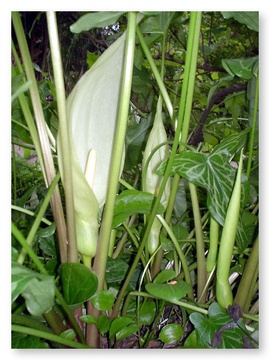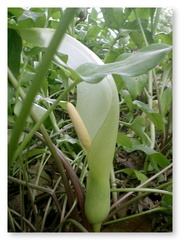 Jacks displaying various stages of inflourescence and contrasting veins on the leaves.
Jacks displaying various stages of inflourescence and contrasting veins on the leaves.  Once fertilized, Jack's hood wilts to reveal a berry cluster.
Once fertilized, Jack's hood wilts to reveal a berry cluster.
Jack in the Pulpit (Arisaema triphyllum) is a herbaceous perennial sometimes divided into three distinct species, A. triphyllum, A. atrorubens, and A. stewardsonii, but many authorities lump them all into A. triphyllum. A member of the arum family like our notable Tabatha the Titan, Jack grows only to about three feet, flowering annually between March and May in this area. As a general rule, arums prefer sub-tropical or tropical moist to wet habitats and are primarily a foliage plant, producing a single inflourescence or "bloom" comprised of a spadix, a fleshy spike bearing hundreds of tiny male and female flowers surrounded by a showy modified leaf bract, or spathe. The spathe is very modest, often displaying a plain green hood over the spadix, exceptionally flashy Jacks may have deep purple stripes on the spathe.
 The bulbous pulpit lures pagan insecta. Though not technically a carnivorous plant, many insects meet their maker within the hooded spathe, due to its slippery, steep, inner walls. Attracted into the "pulpit" by a fungus-like odor produced as a lure for pollinators. After fertilization the spathe wilts to reveal a cluster of shiny berries which ripen to bright red in late summer or early fall. Caution: Calcium oxalate crystals present in the entire plant will cause a powerful burning sensation if eaten raw, though there is historical reference to medicinal use of plant preparations. Like many plants with oxalate compounds (for instance chocolate), drying or slow baking will remove the poison although people with kidney stones or kidney problems are generally discouraged from consuming them. Drying the corm yields a food known as "Indian Turnip".
The bulbous pulpit lures pagan insecta. Though not technically a carnivorous plant, many insects meet their maker within the hooded spathe, due to its slippery, steep, inner walls. Attracted into the "pulpit" by a fungus-like odor produced as a lure for pollinators. After fertilization the spathe wilts to reveal a cluster of shiny berries which ripen to bright red in late summer or early fall. Caution: Calcium oxalate crystals present in the entire plant will cause a powerful burning sensation if eaten raw, though there is historical reference to medicinal use of plant preparations. Like many plants with oxalate compounds (for instance chocolate), drying or slow baking will remove the poison although people with kidney stones or kidney problems are generally discouraged from consuming them. Drying the corm yields a food known as "Indian Turnip".
For a list of other plants found growing in Davis, please visit our Town Flora page where you can also find a listing of more arums.



